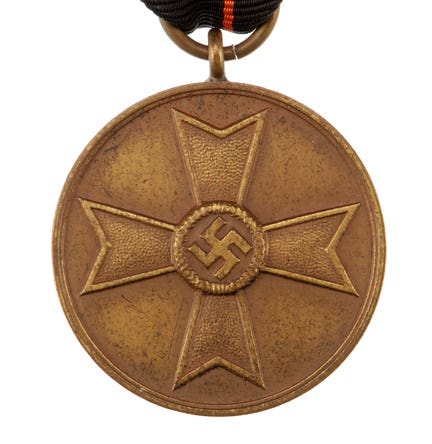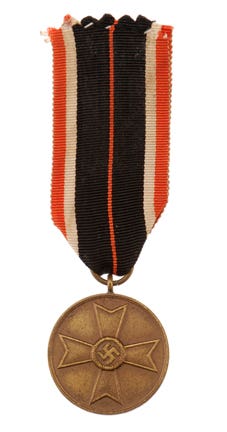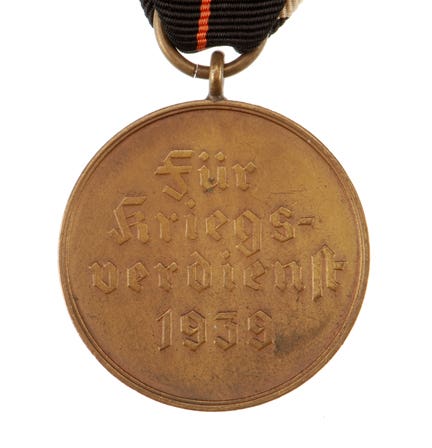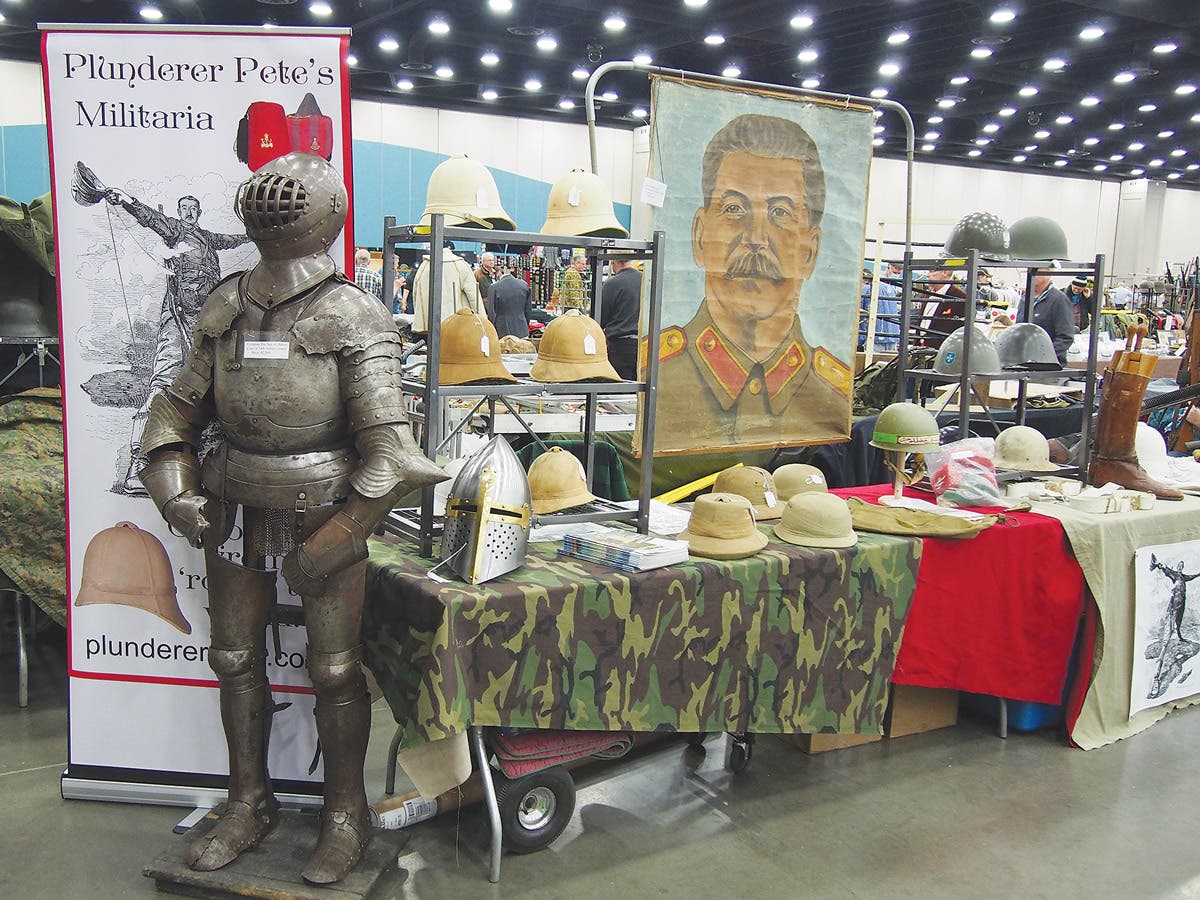Germany’s WWII War Merit Cross
This WW2 reward was for both German (and non-German) civilian and armed forces men and women who had demonstrated distinguished bravery or service to the Third Reich.
One of the key propaganda tools used by Adolf Hitler and the Nationalsozialistische Deutsche Arbeiterpartei (the Nazi Party; “NSDAP”) to take control of the German homeland was their ability to instill a sense of pride in the common people. One tool for achieving this was giving them awards for their public service to the Third Reich.
When Hitler lead the country into the early European conflicts that would become the second World War, a new award was conceived that allowed thousands of soldiers and civilians to be decorated for their non-combative war efforts. He created the Kriegsverdienstkreuz (War Merit Cross) on October 18,1939. It was intended as a reward for both male and female German (and non-German) civilian and armed forces personnel who had demonstrated distinguished bravery or service to the Reich, but not as such as to qualify for the more desirable Iron Cross or other existing meritorious awards.
SECOND CLASS AWARD
The basic design of the War Merit Cross took the form of three grades with the second class (lowest grade) of a bronze (and later bronzed zinc) 49mm Maltese cross overlaid in the center with a canted swastika surrounded by an oak leaf wreath. The reverse center of the medal contained the “1939” (the year of the award’s inception) surrounded by a matching oak leaf wreath.
The second class medal came either with crossed swords (for bravery) or without swords (for service) intersecting the inside corners of the cross with their points extended up. A suspension loop was affixed to the center top arm of the cross which was supported by another loop attached to a red, white, black, white, red ribbon.
The second class cross was typically presented in a paper envelop along with an award document made out to the recipient. The envelopes were imprinted with either Kriegs Verdienstkreuz 2 klasse -mit Schwertern (with swords) or Kriegs Verdienstkreuz 2 klasse - ohne Schwertern (without swords).
The medal could be worn on their tunic pocket when in full parade dress, subservient in position to any combat related awards, in the second button hole of a tunic, on a medal bar, or in ribbon form on a ribbon bar. When the award bearer was in civilian clothing, a button hole ribbon could be worn to designate their achievement.
In total, there were more than 6 million crosses with swords, and 1.6 million crosses without swords awarded before the end of the war.
FIRST CLASS AWARD
First class Merit Service Crosses differed from the second class in that they were pin back rather than suspended from a ribbon and were produced in a silver rather than bronze finish. These finely crafted awards have plain reverses that typically display small manufacturer’s marks under the pins.
The first class awards were presented in hard cases with satin and velveteen linings. An outline of the respective award in silver was imprinted on the box lid. As with most Third Reich awards, recipients were presented with an award document at the time of the presentation.
If an individual had earned both the second and first class crosses, they were to wear the higher of the two awards. By the end of the war, over 500,000 first class Merit Crosses with swords, and 100,000 without swords were given to both Germans and non-Germans for their service to the Reich.
KNIGHT’S CROSS OF THE WAR MERIT CROSS
The Ritterkreuz des Kriegsverdienstkreuzes (Knight’s Cross of the War Merit Cross) was the highest award of the cross series. This decoration was given for outstanding service to the country with the first award presented in May, 1942.
The Knights Cross was larger than the lower awards and produced in hallmarked silver. The cross was suspended from a large ring attached with two slanted arms which, in turn, was connected to a double loop and 45mm-wide red, white and black ribbon. Proper wear required that the long ribbon ends were attached behind the neck, leaving the medal hanging below the wearer’s throat.
The award was housed in a large, well-constructed hard case with a satin and velveteen interior. As with the 2nd and 1st class awards, the recipient also received a detailed presentation document when the award was presented. With only 118 Knight’s Crosses with swords, and 137 without swords awarded, the Knight’s Cross was highly coveted and sought after by many members of the Third Reich hierarchy.
WAR MERIT MEDAL



Though not a cross, the Kriegsverdienstmedaille (War Merit Medal) was instituted in August 1940, as a service and production award for civilians, both German and non-German. The small, round, bronze-colored medal bore a facsimile of the War Merit Cross on the front face. The words Für Kriegs Verdienst (For War Service) were cast in script on the reverse. The top of the medal had a bronzed ring attached which was suspended from a red-white-black-red-black-white-red ribbon.
The medal was issued in a paper packet with Kriegs Verdienstmedaille 1939 printed on the face. With more than 5 million awarded, the War Merit Medal is one of the more prolific civilian medals given out during the Third Reich.
Encouraging the people of the Nazi occupied territories to put forth their best efforts for the good of the Reich was a mainstay of the German propaganda machine, and a basic foundation block of Hitler’s regime. Each one of the millions of awards given for non-combatant bravery, service, and dedication tells a story of an individual’s sacrifice made for what he or she was erroneously lead to believe was for the good of their country at the time.
As an Amazon Associate, Military Trader / Military Vehicles earns from qualifying purchases.
Chris William has been a long-time member of the collecting community, contributor to Military Trader, and author of the book, Third Reich Collectibles: Identification and Price Guide.
"I love to learn new facts about the world wars, and have had the good fortune to know many veterans and collectors over the years."
"Please keep their history alive to pass on to future generations".








